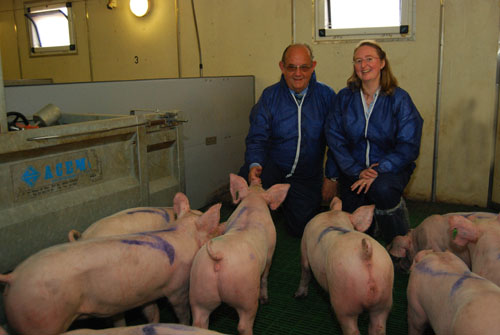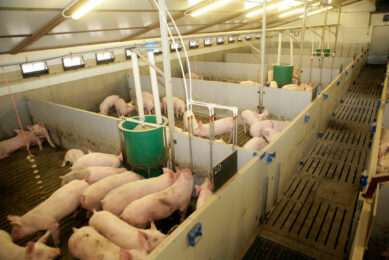Research: Does it pay to take pigs to heavy slaughter weights?

It is well known that as a pig grows it becomes less efficient at converting feed to weight gain. Therefore, depending on pig price and feed costs there is an optimum slaughter weight which will maximise profitability.
Presently in Northern Ireland, there is a trend to slaughter pigs at ever increasing slaughter weights with the expectation of increasing profit from each individual pig. However, the point at which this becomes uneconomic is not known and due to current high feed costs it has never been more important to know if the deterioration in feed use efficiency as pigs get heavier results in decreased profitability. Results from recent work at the Agri-Food and Biosciences Institute (AFBI), funded by Pig ReGen Ltd and DARD and conducted at AFBI Hillsborough using the unique AFBI/PCM (Preferred Capital Management) research facility should help producers make decisions regards the weight to slaughter pigs.
Research
One hundred and fifty three Tempo cross bred pigs were housed in the specialised pig research facility which records the daily feed intake of individual pigs housed in groups. The feed intake of each pig was recorded from 16 weeks of age to a slaughter weight of 120 kg. Pigs were weighed weekly and the feed conversion ratio of each pig could therefore be calculated. Pigs were sent for slaughter over a three week period. Twenty nine pigs reached at least 120 kg when they were approximately 22 weeks of age and they were sent in week 1 (fast growing pigs), 43 pigs reached at least 120 kg the following week (medium growing pigs) and the remaining 80 pigs were sent in the 3rd week (slow growing pigs). Table 1 outlines the growth performance of these pigs. Using the data from these pigs it was possible to produce equations to investigate the change in FCR as pig weight increased.
Results
The majority of the fast growing pigs were boars and they had an average daily gain between weaning and slaughter of 891 g per day. The medium growing pigs were a mixture of gilts and boars and had an average daily gain of 853 g per day between weaning and slaughter. The slow growing pigs were mainly gilts and had an average daily gain of 770 g per day between weaning and slaughter. It should be noted that the growth rate of all the pigs was considered good.
Table 1 reports the performance characteristics of the fast, medium and slow growing pigs. As expected the slow growing pigs were the lightest at the start of the test period and the fast growing pigs were the heaviest (Table 1). In this study it took an extra 26.2 kg of feed per pig to get the slow growing pigs to 120 kg compared with the fast growing pigs. This was mainly due to the fact they were on farm for a longer period of time since they were lighter at the start of the test period. Overall between 16 weeks of age and 120 kg the FCR of fast growing pigs was only 3% better than that of medium and slow growing pigs which had a similar FCR (Table 1). It is highly likely the better FCR of fast growing pigs was due to the fact they were mainly boars.
Figure 1 shows the feed intake of the fast, medium and slow growing pigs for each 10 kg increase in slaughter weight between 90 and 120 kg. As slaughter weight increased it took an increasing amount of feed to gain 10 kg which indicates that FCR was deteriorating, as expected. However, FCR deteriorated at a similar rate for the fast, medium and slow growing pigs. Assuming feed cost of a finisher ration is £280, it took a feed cost of £6.61 to increase slaughter weight from 90 to 100 kg, £6.86 to increase slaughter weight from 100 to 110 kg and £7.22 to increase slaughter weight from 110 kg to 120 kg. In order for producers to establish if it is economical to take their pigs to heavy slaughter weights the back fat depth of the pigs at these heavy weights needs to be considered. Producers also need to factor in the feed cost to take pigs to 90 kg which will be different for each farm. Furthermore, in this study it cost an extra £7.34 (26.2 kg of feed) to feed the slow growing pigs from 16 weeks of age to 120 kg compared with the fast growing pigs. However, it is reiterated that the growth rate of all the pigs in this study was good and even the ‘slow’ growing pigs were on average 117 kg at 169 days of age.
In this study, the space allowance of pigs was adequate up to 120 kg. If space allowance is restricted, previous research has shown that in addition to other negative implications, feed intake will decrease and growth rate will be slower. Therefore if producers plan to take pigs to heavy slaughter weights they need to ensure space allowance is adequate in order to maximise growth rate.
It is accepted that on some farms a pen of very slow growing pigs can often remain after the ‘3 week’ clearance. Data is continuously being gathered to investigate the FCR of these very slow growing pigs.
In conclusion, whilst the FCR of all pigs deteriorated as pig weight increased, the rate of deterioration was similar for the fast, medium and slow growing pigs. It should be noted that although the pigs were sent for slaughter over a 3 week period, which is similar to commercial practice, the growth rate of even the slow growing pigs was good. They achieved weights of on average 117 kg at 169 days of age. Overall it appears economically beneficial to increase slaughter weight to 120 kg for pigs with good growth rates. However producers need to examine the effect of this practice on back fat depth of their own pigs (using PiGIS for example), the cost of feed to get their pigs to 90 kg and if space allowance is adequate.
Figure 1: Feed intake for each 10 kg increase in slaughter weight between 90 and 120 kg for fast, medium and slow growing pigs.
(By Elizabeth Magowan, Agri-Food and Biosciences Institute, Hillsborough)











